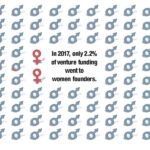A study from Oregon State University College of Business suggests the best way to eliminate gender bias is to remove humans partially from the hiring process.
Gender bias in hiring and promoting workers has been well-documented. While the moral case against gender discrimination in business is strong, a recent study from Oregon State University found gender discrimination is also costly and difficult for even well-intentioned companies to guard against.
The study analyzed gender discrimination data, which was gathered by sending identical resumes to open job listings. The only distinction was the name, which alternated between male and female. The data was used to run thousands of hiring simulations and produce different employment outcomes.
The results show gender bias to be expensive as employers often passed over the most suitable person for the job. Furthermore, gender bias was present even at companies that had undergone anti-bias training. The results suggest humans may be incapable of eliminating bias entirely, and may not be as effective as predictive software when making hiring decisions.
The good news is that gender bias in hiring is less frequent than in previous decades. If a potential employee’s job-worthiness were rated on a scale of one to 100, gender bias was found to swing the final number by one. In the 1980s, similar experiments showed a gender bias swing of four.
While that may seem like reason to celebrate, in a field of competitive candidates the results of just a single point are large. Gender bias results in between 30% and 40% lower odds of the most suitable candidate being selected for a position or a promotion.
The results of gender discrimination were also shown to be costly. Due to overhead, loss of productivity and cost of replacing workers who should not have been hired in the first place, gender bias was found to cost companies an average of $7,000 per employee per year.
RELATED STORY: Momentum Grows for Women on Boards
Gender bias was also shown to work against men in certain circumstances. While women are generally seen as less of a fit for executive roles, resumes from men were also rejected more often for health care and education positions such as nurses and kindergarten teachers.
The study finds companies with anti-bias training did not fare any better on hiring decisions than companies without. Jay Hardy, assistant professor of management at Oregon State University College of Business and lead author of the study, explains that bias is instinctual in humans and may be impossible to defeat entirely.
“Science has shown the physical differences between men and women, especially as it relates to health, but the idea that there are significant psychological differences is a notion that has proven difficult to dispel,” says Hardy. “Bias is a natural function of our brains, even in people with the best intentions.”
Despite the fact that people are more aware of gender bias than in the past, the best way to take bias out of the hiring process may be to limit human involvement.
Job hiring software is nothing new. Artificial intelligence is routinely used by recruiters to sort through large numbers of resumes. But advancements in the technology have potentially made predictive software a more ethical alternative to hiring committees.
“We need to remove human judgment when we can,” says Hardy. “People don’t want to hear it, but we need to look into the power of algorithms.”
Modern Hire, an AI-powered hiring platform, is already used by companies like Amazon and CVS Health to eliminate gender and racial bias in hiring. By evaluating candidates based on data and personality traits obtained from online tests, AI tools have the potential to remove bias from the equation.
Not all AI tools have been shown to be inclusive, however. Some software applications have shown large bias, especially those that use facial recognition.
Recruiters may have to accept that their practices could have more bias than they thought. Instead of more anti-bias training, creative solutions to hiring and promoting workers may be needed to limit human fallibility and save companies money.
To subscribe to Oregon Business, click here.







